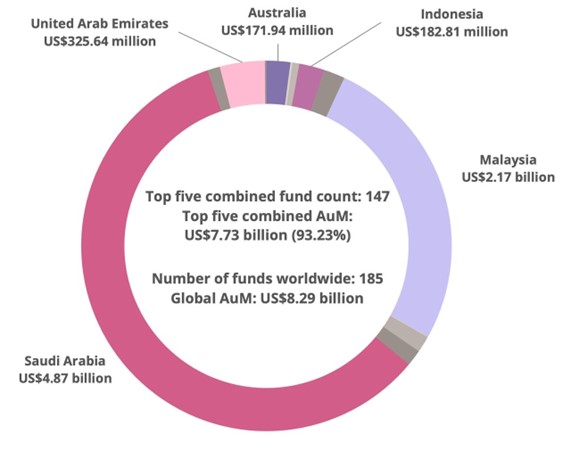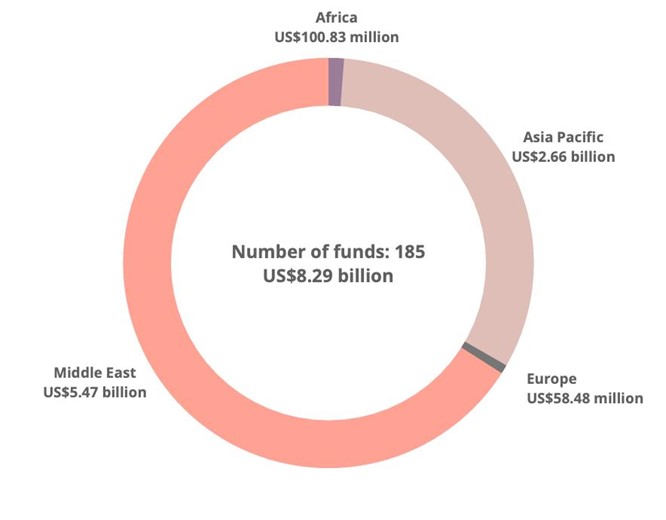Key highlights:
- Global Islamic mixed asset fund assets under management (AuM) stood at US$8.29 billion in Q1 2024.
- Saudi Arabia holds the biggest number of Islamic mixed asset funds.
- Mixed asset funds account for 8.28% of total Islamic fund market.
Overview
The mixed asset investment strategy involves blending various asset classes; these typically encompass fixed income, equities and cash. The primary objective of mixed asset funds would be to achieve consistent returns regardless of market fluctuations, they are categorized as having medium- to low-risk investment strategies. Fund managers can adjust exposures to different asset classes based on prevailing economic conditions, ensuring effective return management.
Chart 1: Global Islamic mixed asset funds AuM breakdown by region

According to the IFN Investor Fund Database, Islamic mixed asset funds globally, excluding Iran, have amassed a total value of US$8.29 billion across 185 funds as of the 31st March 2024. The Middle East leads in AuM with US$5.47 billion, followed by the Asia Pacific region with US$2.66 billion. The African and European regions have comparatively smaller AuM, with US$100.83 million and US$58.48 million respectively. (See Chart 1.)
Saudi Arabia holds the top position globally in terms of AuM with a staggering US$4.87 billion, followed by Malaysia at US$2.17 billion. The UAE comes in third with a total of US$325.64 million, and Australia follows with US$171.94 million. Mixed assets in Indonesia come in with a total of US$182.81 million. The total for these five nations makes up 93.23% of the AuM of the global mixed asset funds. (See Chart 2.)
Chart 2: Top five largest markets for Islamic mixed asset funds by AuM

AuM growth
AuM of Islamic mixed assets in Africa and the Middle East saw growth within the first three months of 2024. Conversely, Asia Pacific and Europe witnessed a decrease in AuM, with declines of 2.28% and 2.63% respectively.
- Africa: Up by 3% to US$40.85 million from US$39.66 million.
- Middle East: Up by 0.31% to US$5.47 billion from US$5.45 billion.
- Asia Pacific: Down by 2.28% to US$2.66 billion from US$2.72 billion.
- Europe: Down by 2.63% to US$58.48 million from US$60.05 million.
Table 1: Top performing Islamic mixed asset funds by region in Q1 2024
| Region | Fund | Fund manager | Three-month returns (%) |
| Asia Pacific | Astute Dana Al-Faiz | Astute Fund Management | 12.08 |
| Middle East | Al Rayan GCC Fund | Al Rayan Investment | 13.4 |
| Africa | 27four Shariah Multi-Managed Balanced Fund | 27 Four Investment Managers | 2.04 |
| Europe | Global ESG Momentum Allocation | Arabesque AI | 2.2 |
Note: Data on Islamic mixed assets in America not available
New players and products
There were eight mixed asset funds launched across five regions in 2023, with a total combined AuM of US$690.23 million. Half of the funds were launched from Saudi Arabia with a combined AuM of US$654.38 million, making up 95% of the AuM of all 2023 new fund launches. Two of the four remaining funds were from Pakistan with its Pak-Qatar Asset Allocation Plan I and Plan II fund; one from the UK, the Franklin Shariah Global Multi-Asset Income Fund; and one from Kenya, the Mansa-X Shariah fund. H1 2024 also witnessed two new mixed asset funds from Alkhabeer Capital with their Diversified Income Fund 2030 and SEDCO’s Capital Multi Asset Traded Fund. Both funds went public on the 28th April 2024 and 19th May 2024 respectively and each fund targets a capital of SAR1 billion (US$266.63 million).
Table 2: Largest Islamic mixed asset funds as at the end of Q1 2024
| Fund | Fund Manager | AuM (US$ million) |
| SNB Capital Diversified Saudi Riyal Fund | SNB Capital | 1,660.18 |
| Public Islamic Asia Tactical Allocation Fund | Public Mutual | 616.2 |
| Riyad SAR Trade Fund | Riyad Capital | 605.2 |
| Al Rajhi Growth Fund | Al Rajhi Capital | 490.67 |
| Al Rajhi Monthly Distribution Fund | Al Rajhi Capital | 372.01 |
Outlook
It is always a tricky proposition for multi-asset fund managers who must carefully balance equities and bonds in the face of inflation, risk and volatility while searching for the alpha — and 2024 will be no exception.
Analysts are expecting an ‘economic normalization’ or return to normal (or closer to normal) post-pandemic as inflation eases, which could be a boost for corporate earnings. The US Federal Reserve in May decided to hold its policy rate steady although some are forecasting two cuts this year as it recalibrates its policies, a move that will also reverberate across the globe including in Saudi Arabia and Malaysia.
Which asset classes then should investors turn to? It depends on whom you ask. Some believe the 2023 stock rally could last this year — there are also potentially positive signals out of the GCC and Southeast Asia with more companies going public and the regulators attempting to involve more SMEs in the equity capital markets thereby offering pockets of growth for Islamic investors.
But there are also others who see opportunities in the fixed income space predicated upon impending rate cuts, making Sukuk (and bonds) an attractive avenue to offer protection from true inflation.
This report was produced by Aravinth Rajendran and Elliot Yip, financial data analysts at IFN Investor.






